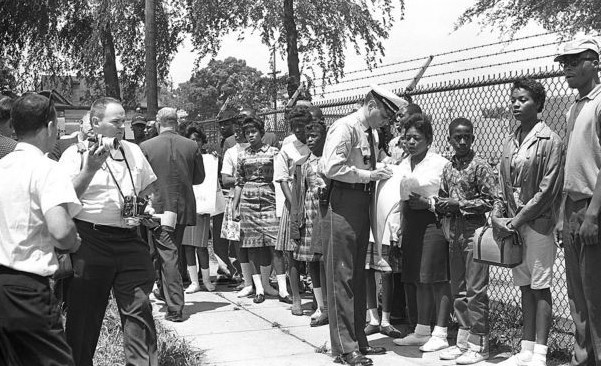Early in 1963, Southern Christian Leadership Conference (SCLC) leaders, Dr. Martin Luther King, Reverend Ralph Abernathy, and local Birmingham leader of the Alabama Christian Movement for Human Rights Fred Shuttlesworth came together to lead a campaign to desegregate Birmingham, Alabama, a city notorious for its discriminatory practices. A plan was put in place for a series of protests. Mass meetings were held at the 16th Street Baptist church with local adults and their children including many training for non-violent peaceful protests.
In April, the first wave of protests resulted in numerous arrests, including Dr. King, who wrote the “Letter from a Birmingham Jail” during his incarceration. A local circuit court judge issued an injunction against additional protests and when they continued, there were mass arrests of adult protesters Adult demonstrators also suffered the threat of being fired from their jobs for participating in protests. These actions resulted in fewer adult volunteers to the movement. Consequently, SCLC member James Bevel argued it was time to involve the youth in the movement. Agents went out to local schools, recruiting high school quarterbacks and cheerleaders to influence their peers to attend meetings and get involved in the movement.
On the morning of May 2, 1963, thousands of African American students from Birmingham and surrounding communities skipped school. Ranging in age from 7 to 18, they gathered at the 16th Street Baptist Church. After receiving instructions, they were sent out in groups of 10-50 children at a time with picket signs. On the first day, hundreds of children were arrested and detained. On the second day, the children were met by Birmingham police who used the same tactics they had applied to adults; bombardment with water hoses, beatings with batons, and attacks by guard dogs. The children continued to protest despite the tactics used, and over two thousand youth were arrested over the following days. Images of the children and teenagers being attacked in these protests appeared in newspapers and on television and sparked outrage across the nation and around the world. On May 5, these young protesters marched to City Hall demanding justice for youth already incarcerated and an end to racial segregation in the city.
Local businesses and city officials began to feel the pressure of the movement. They agreed to meet with the civil rights leaders to discuss a plan to end the protests. On May 10, an agreement was reached and city officials released all who had been jailed and began desegregating local businesses. In the wake of the protests, the Birmingham Board of Education announced that all students involved would be expelled, but that decision was overturned by the U.S. Court of Appeals.
In June, President John F. Kennedy announced his intentions to establish new civil rights legislation that would end segregation in Birmingham. He was motivated by events in Birmingham including student protest marches which were now collectively called the Birmingham Children’s Crusade. The children’s protests led to a series of crucial events over the next year. Dr. King led the March on Washington in August 1963 and in September, the Ku Klux Klan bombed the 16th Street Baptist Church, killing four young girls. President Kennedy was assassinated in November 1963 and President Lyndon Johnson signed the 1964 Civil Rights Act on July 2, precisely 14 months after the first students marched in Birmingham.

